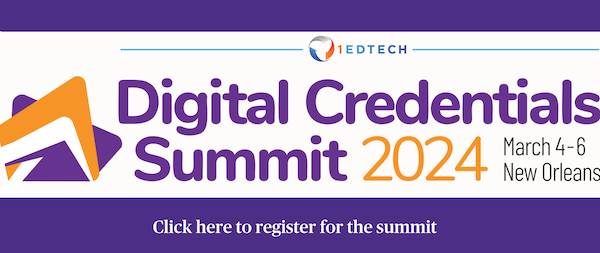Published on
Define, Refine and Design: A Collaborative Approach for Introducing Microcredentials to Your Learning Ecosystem

As higher education institutions seek to meet learners’ needs in a swiftly changing marketplace, the benefits of flexible, short, skills-focused programs have come into focus. Many institutions now recognize the potential of adding microcredential programs into their academic portfolios. The University of Colorado Denver, which is situated among many of the largest employers in the state, serves a sizeable population of adult learners and transfer students. Recently at CU Denver, we have focused on shoring up the infrastructure for our microcredential offerings. One core element of this initiative: internal working groups comprised of faculty and staff from a range of campus teams. Our engagement with external partners has also led to some important discoveries as we explore how to respond to learner and market needs nimbly and proactively.
Through this collaborative work, we have identified several obstacles and opportunities for introducing microcredentials as a key campus strategy: (1) developing a shared understanding of microcredentials, (2) identifying and prioritizing solutions for process inefficiencies, (3) clarifying resources for determining market need and (4) creating supports for program developers.
Develop a Shared Understanding of Microcredentials
Central to the ability to introduce and grow microcredential programs is the need for a shared understanding of the term microcredential. One way to begin this process is through an examination of existing definitions. At CU Denver, we searched for existing definitions across a variety of groups, including national organizations seeking to influence the field, industry partners who produce microcredential assets (e.g., digital badges) and other institutions of higher education (e.g., State University of New York, University of Wisconsin Milwaukee, Northwestern College). These definitions were then coded to identify common elements. Through this exercise we learned that 75% of the definitions indicated that microcredential programs must be of smaller scope; and 75% indicated that, as a record of learning, the associated skill must be assessed or demonstrated. These and other findings from this exercise influenced our definition conversations.
Institutional priorities and culture are also highly influential when defining such a complex and nebulous term. Will microcredential programs refer to only non-credit activities such as professional development? Will they be limited to for-credit activities such as stackable credentials? For many institutions, microcredential programs can include both non-credit and for-credit offerings; as such, their definitions are purposefully broad, reducing specificity and clarity. To mitigate this constraint, it may be helpful to situate microcredential programs within your existing learning ecosystem (e.g., leveraging known program durations, modalities, and types). We also recommend creating a diagram that visualizes how various credential-bearing programs are situated within your institutional ecosystem. Our discussions led to a diagram showing that microcredential programs will be nested within a larger circle of credential programs, and programs that award skill badges will be nested within microcredential programs.
Particularly for these defining and refining conversations, it would benefit institutions to move slowly and inclusively at the beginning, involving many constituents in this critical, collaborative work. We also developed a comprehensive communication plan for this phase of the work and regularly reinforced that the initially proposed and launched definitions will likely require iteration and refinement as we develop a larger portfolio of microcredential programs. Microcredential program archetypes that are already broadly understood and accepted within an institution are likely to be a good start for the initial launch. As shared understanding expands, and the infrastructure improves, innovations will as well, creating space for new and innovative archetypes.
Identify and Prioritize Solutions for Process Inefficiencies
Microcredential programs need to be developed and offered on relatively short timelines. Without process efficiency, the benefits that they offer as being timely and adaptable to employer needs are undermined. Unfortunately, in many higher education environments, efficient program development can conflict with long-standing approval processes. These processes are important for many reasons: traditional program accreditation, program duplication prevention, coordination of learning outcomes and evaluation practices, and others. However, revisiting these processes is vital for scaling microcredential programs. Can parts of the process be skipped or truncated without sacrificing quality? This is a particularly helpful question in the for-credit realm when microcredentials come from existing courses. It’s more challenging to reconsider existing practices for process efficiency: What are the opportunities for streamlining program development?
The non-credit space presents different challenges. At institutions where Continuing Education may be structured within separate schools and colleges or where administrative units offer programs (such as faculty professional learning), there may be multiple processes to reconcile. There is also a wider variety of non-credit program archetypes with rarely used, distinct approval processes. Mapping these processes—and creating shared repositories for easy access—may help to identify commonalities and opportunities to streamline. When we prioritize process efficiency and transparency, we can maintain institutional knowledge and empower our faculty and staff to innovate.
Clarify Resources for Determining Market Need
Many faculty and staff, as content experts, aren’t equipped with knowledge of market intelligence and in-demand workforce skills. Microcredential programs are often responsive to employer, industry and community need. Subsequently, program developers need accessible market data to ensure their programs are aligned to tangible needs. Here are a few examples of valuable market intelligence investments that may increase the likelihood of success for microcredential programs: hiring a market intelligence analyst or team, self-service dashboards, industry and community advisory groups, and partner and student survey support.
Create Supports for Program Developers
While shared understanding and process efficiency are important, these layers of infrastructure will not move the needle on microcredential development if there are no faculty and staff interested in developing programs. Even the most passionate developer will lose motivation without partners and support to help them along the way. There are many key areas of support in which to invest:
- Pedagogical (instructional design, faculty professional learning, communities of practice)
- Administrative (program interest and proposal forms, unified registration system, marketing support, billing streams)
- Technological (LMS integrations and constraints, badging support and integration, transparency on associated learner costs)
- Financial (identification and navigation of funding models, financial incentives for program developers, identification of industry partners, financial aid qualification)
- Motivational (inclusion of program development in promotion and tenure decisions, consideration of how educational innovations may negatively impact student evaluations)
In our experience, adopting an inclusive approach to identifying and crafting infrastructural supports for microcredentials is vital; through partnership with passionate faculty and staff colleagues, we avoided some of the pitfalls that can derail complex initiatives, while generating shared investment and enthusiasm about our microcredential work at CU Denver.
Higher education institutions have faced many disruptive changes over the last few years: emergency remote teaching, the rapid advancement and access to AI, and the growing population of adult learners seeking to upskill and reskill. Each of these changes, however, presents another opportunity for reflection. The shift to online highlighted the need for pedagogical quality. The emergence of AI is leading to discussions of how AI should be integrated—or avoided—in formal learning environments. Similarly, the introduction of microcredential programs can highlight opportunities for improvement in program development and launching infrastructure. Just as our learners are adapting to a changing marketplace, higher education must adapt to our learners’ changing needs.

Author Perspective: Administrator



